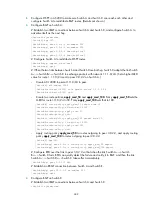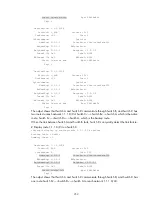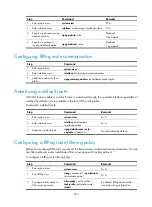
255
Step Command
Remarks
2.
Configure an IPv6 static route.
•
Approach 1:
ipv6 route-static
i
pv6-address prefix-length
{
interface-type interface-number
[
next-hop-address
] |
next-hop-address
|
vpn-instance
d-vpn-instance-name
nexthop-address
} [
preference
preference-value
]
•
Approach 2:
ipv6 route-static
vpn-instance
s-vpn-instance-name
&<1-6>
ipv6-address
prefix-length
{
interface-type
interface-number
[
next-hop-address
] |
nexthop-address
[
public
] |
vpn-instance
d-vpn-instance-name nexthop-address
}
[
preference
preference-value
]
Use either approach.
The default
preference of IPv6
static routes is 60.
NOTE:
If you specify a broadcast interface, such as an Ethernet interface or a VLAN interface, as the output
interface for a static route, you must specify the next hop address.
Displaying and maintaining IPv6 static routes
Task Command
Remarks
Display IPv6 static route
information.
display ipv6 routing-table
protocol
static
[
inactive
|
verbose
] [
|
{
begin
|
exclude
|
include
}
regular-expression
]
Available in any view
Remove all IPv6 static routes.
delete ipv6
[
vpn-instance
vpn-instance-name
]
static-routes
all
Available in system view
To delete a single IPv6 static route, use the
undo ipv6 route-static
command. To delete all IPv6 static
routes, including the default route, use the
delete ipv6 static-routes all
command.
For more information about the
display ipv6 routing-table protocol static
[
inactive
|
verbose
] [
|
{
begin
|
exclude
|
include
}
regular-expression
] command, see
Layer 3—IP Routing Command Reference
.
IPv6 static routing configuration example
Network requirements
As shown in
, configure IPv6 static routes so that hosts can reach one another.
















































